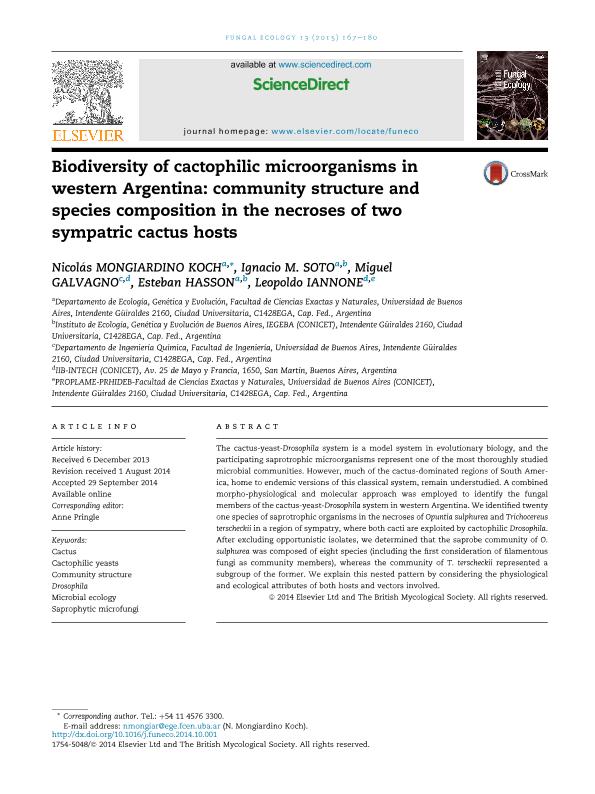Artículo
Biodiversity of cactophilic microorganisms in western Argentina: community structure and species composition in the necroses of two sympatric cactus hosts
Mongiardino Koch, Nicolás ; Soto, Ignacio Maria
; Soto, Ignacio Maria ; Galvagno, Miguel Angel
; Galvagno, Miguel Angel ; Hasson, Esteban Ruben
; Hasson, Esteban Ruben ; Iannone, Leopoldo Javier
; Iannone, Leopoldo Javier
 ; Soto, Ignacio Maria
; Soto, Ignacio Maria ; Galvagno, Miguel Angel
; Galvagno, Miguel Angel ; Hasson, Esteban Ruben
; Hasson, Esteban Ruben ; Iannone, Leopoldo Javier
; Iannone, Leopoldo Javier
Fecha de publicación:
02/2015
Editorial:
Elsevier
Revista:
Fungal Ecology
ISSN:
1754-5048
Idioma:
Inglés
Tipo de recurso:
Artículo publicado
Clasificación temática:
Resumen
The cactus-yeast-Drosophila system is a model system in evolutionary biology, and the participating saprotrophic microorganisms represent one of the most thoroughly studied microbial communities. However, much of the cactus-dominated regions of South America, home to endemic versions of this classical system, remain understudied. A combined morpho-physiological and molecular approach was employed to identify the fungal members of the cactus-yeast-Drosophila system in western Argentina. We identified twenty one species of saprotrophic organisms in the necroses of Opuntia sulphurea and Trichocereus terscheckii in a region of sympatry, where both cacti are exploited by cactophilic Drosophila. After excluding opportunistic isolates, we determined that the saprobe community of O. sulphurea was composed of eight species (including the first consideration of filamentous fungi as community members), whereas the community of T. terscheckii represented a subgroup of the former. We explain this nested pattern by considering the physiological and ecological attributes of both hosts and vectors involved.
Palabras clave:
Ecología Evolutiva
,
Ecología de Comunidades
,
Mutualismo
,
Evolución
Archivos asociados
Licencia
Identificadores
Colecciones
Articulos(IEGEBA)
Articulos de INSTITUTO DE ECOLOGIA, GENETICA Y EVOLUCION DE BS. AS
Articulos de INSTITUTO DE ECOLOGIA, GENETICA Y EVOLUCION DE BS. AS
Articulos(IIB-INTECH)
Articulos de INST.DE INVEST.BIOTECNOLOGICAS - INSTITUTO TECNOLOGICO CHASCOMUS
Articulos de INST.DE INVEST.BIOTECNOLOGICAS - INSTITUTO TECNOLOGICO CHASCOMUS
Citación
Mongiardino Koch, Nicolás; Soto, Ignacio Maria; Galvagno, Miguel Angel; Hasson, Esteban Ruben; Iannone, Leopoldo Javier; Biodiversity of cactophilic microorganisms in western Argentina: community structure and species composition in the necroses of two sympatric cactus hosts; Elsevier; Fungal Ecology; 13; 2-2015; 167-180
Compartir
Altmétricas



